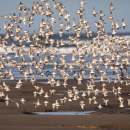Estuaries are among the most productive natural systems on earth due to the mixing of nutrients from land and sea. Coastal areas, including estuaries, comprise less than 10% of the nation’s land area yet support a significant number of wildlife species, including 75% of migratory birds, nearly 80% of fish and shellfish, and about half of all threatened and endangered species.
The Bear River Estuary Restoration Project returned portions of the Lewis, Porter Point and Riekkola Units back to historic estuarine conditions, increasing open water, intertidal flats, and salt marsh salt marsh
Salt marshes are found in tidal areas near the coast, where freshwater mixes with saltwater.
Learn more about salt marsh habitat. Restoration has benefited a diverse array of species including chum and Chinook salmon, shorebirds, waterfowl and other migratory birds, as well as contributed to the overall health of Willapa Bay.
The restoration project took place in five phases. Phase 1 was completed during the summer of 2012 with the removal of the dike and fish ladder at the Lewis Unit. This effort restored 160 acres of estuary and is already being used by shorebirds, waterfowl and salmon. Phase 2 was completed during the summer of 2013 and 2014. This phase removed the dike and fish ladder in the Porter Point Unit and restored 140 acres of estuary. The engineering design to modify the existing interior dike within the Riekkola Unit (Phase 3) was completed in 2015. Phase 4, modification to the interior dike, called Parker Slough Dike, was completed in 2016. Removal of the outer dike in the Riekkola Unit, restoring the remaining 200 acres of estuary (Phase 5) was completed in 2018.
The goal of habitat restoration is to help rebuild a healthy, functioning natural system. Dike removal is only the first step in the restoration process.
Many Hands Make Light Work
An effort this size takes a lot of planning and resources. Although this restoration was mostly completed by Refuge staff, a multitude of partners contributed to the success of this project. Learn more about Willapa NWR's partners on the Bear River Estuary Restoration Project:
- AMEC Earth & Environmental*
- Audubon Washington
- Columbia Land Trust
- Columbia River Estuary Study Taskforce
- Cowlitz Indian Tribe
- Craig Enterprises*
- Ducks Unlimited
- Environmental Protection Agency
- Forterra
- Friends of Willapa NWR*
- Hancock Timber Resouce Group
- Herrera Environmental Consultants*
- Grays Harbor Audubon Society
- Lower Columbia River Estuary Partnership
- NDC Timber*
- Pacific Marine & Estuarine Fish Habitat Partnership (Phase 2)*
- Salmon Recovery Funding Board (Design for Phases 1, 2 and 5)*
- Shoalwater Bay Indian Tribe
- Sustainable Fisheries Foundation
- The Nature Conservancy
- The Watershed Company*
- Vancouver Audubon Society
- Washington Coast Sustainable Salmon Partnership
- Washington Department of Natural Resources
- Washington State University Long Beach Research and Extension Unit*
- Willapa Bay Fisheries Enhancement Group (Design for Phases 1, 2 and 5)*
- Willapa Hills Audubon Society
*Contributor or Consultant
